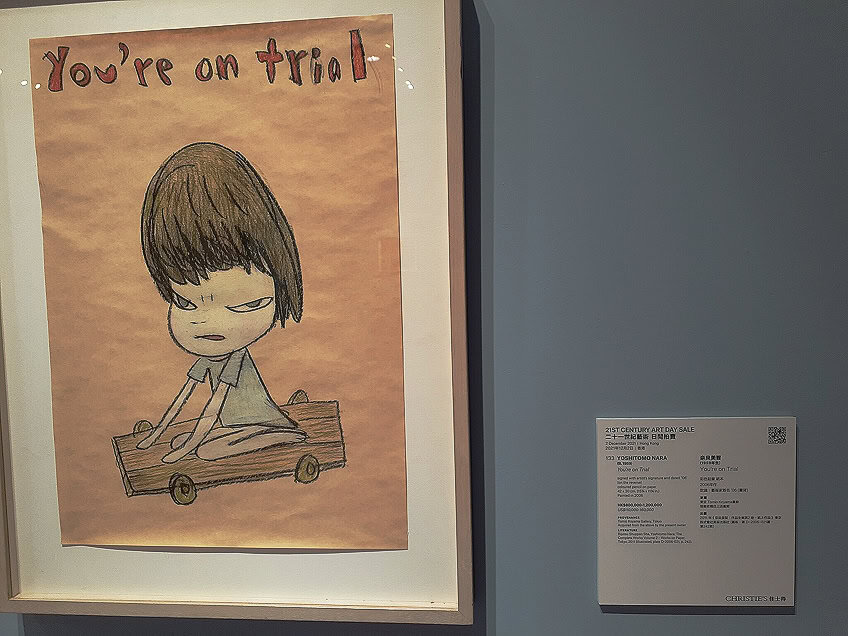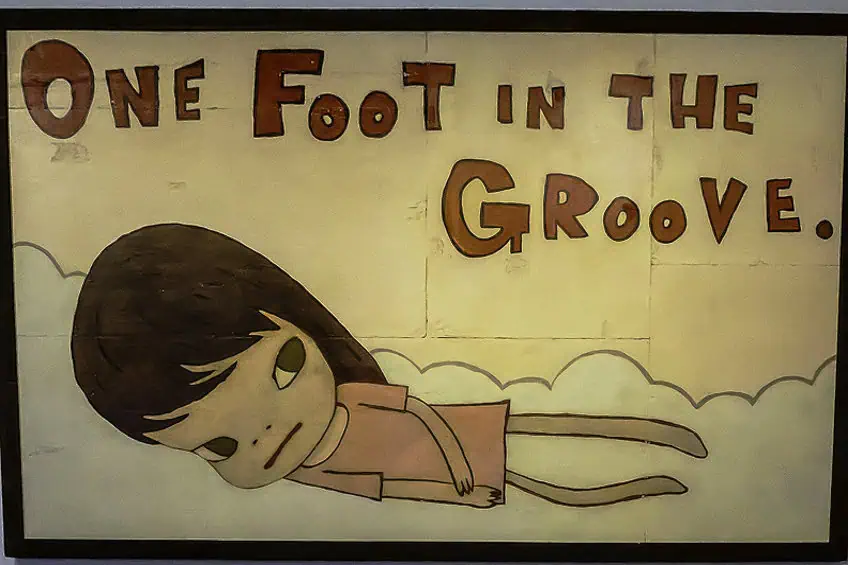Yoshitomo Nara – The Pop Culture Provocateur
Yoshitomo Nara, a contemporary Japanese artist born in 1959, is renowned for his captivating and emotive works that blend elements of pop culture, childhood innocence, and introspection. His iconic depictions of wide-eyed children and animals often convey a sense of both vulnerability and defiance, inviting viewers into a world that oscillates between the playful and the profound. Nara’s distinctive style, characterized by bold lines and vivid colors, has made him a leading figure in the global art scene, with exhibitions in major museums and galleries worldwide. His art continues to resonate with audiences, exploring themes of identity, rebellion, and the universal experiences of growing up and navigating life’s complexities.
Key Takeaways
- Yoshitomo Nara is a prominent Japanese artist recognized for his colorful and emotionally expressive art.
- His work is characterized by a blend of childhood innocence and rebellion, influenced by popular culture and personal experiences.
- Nara’s global impact is evidenced by his numerous international solo exhibitions and significant role in contemporary art.
Early Life and Education
| Birth | December 5, 1959 |
| Death | Present |
| Place of Birth | Hirosaki, Japan |
| Genre of Work | Contemporary art, Pop art, Neo-Pop art, and Superflat art |
Yoshitomo Nara, a contemporary artist from Japan, has made significant contributions to the global art scene with his distinctive style and expressive artwork. Born in Hirosaki, Aomori Prefecture, he has cultivated a reputation for his colorful paintings and sculptures. Nara draws upon elements of popular culture to create images that often feature children and animals with nuanced expressions, straddling the line between innocence and defiance.

Nara’s work is deeply influenced by his experiences and emotions, as well as by the punk rock music of his youth. His children and creatures, sometimes armed with weapons or inscribed with rebellious phrases, convey a range of emotions, from solitude to aggression. These works tap into the complexities of childhood and the human condition, resonating with audiences around the world. Nara’s art has been showcased in nearly 40 solo exhibitions since 1984, making him a central figure in contemporary Japanese art and beyond.
Formative Years in Japan
Yoshitomo Nara was born in 1959 and spent his early years in Hirosaki, a city in Aomori Prefecture. Aomori’s remote location nurtured Nara’s independent streak, as he often found himself alone, with only his imagination for company. This isolation later played a significant role in the themes of solitude evident in his artwork. As a child, Nara’s introduction to Western music and culture came through the American military radio station Far East Network. The blend of Japanese and American popular cultures would come to influence his creative direction.
His education began in earnest with a master’s degree from Aichi University of the Arts, completed in 1987.
Studies in Germany
Yearning for broader horizons, Nara moved to Germany in 1988, where he enrolled at Kunstakademie Düsseldorf. His time in Germany was pivotal, exposing him to new artistic methods and philosophies that would significantly impact his work.

The experience living and studying in a different cultural milieu expanded Nara’s artistic perspective. It was here that he embraced the core principles that would infuse his characters with a distinctive depth and sensibility, traits that have become synonymous with his name.
Artistic Style and Influences
Yoshitomo Nara’s artistic style is distinctive, combining elements of both Western and Eastern cultures, particularly drawing from the realms of contemporary media and traditional art forms. His work encapsulates a range of influences, from children’s literature to popular music and historical art movements.
Developing a Unique Aesthetic
Nara’s work is best known for its fusion of kawaii (cuteness) seen in modern Japanese culture with deeper undertones of solitude and rebellion. His usage of ink and paper is traditional, but the expressions and emotional depth found in his subjects are contemporary. Many of his paintings feature childlike figures, often with oversized heads and penetrating, expressive eyes. These characters frequently exhibit dualities of innocence and malevolence, mirroring his interest in themes like the innocence of youth versus the complexities of adult life.

Nara’s signature style is also influenced by his love for music, particularly rock and punk genres, which resonates in the defiant stance of his characters. Despite their simplicity, the figures in his artworks carry a powerful emotional impact, capturing feelings of angst and alienation that echo the rebellious spirit of the musical styles he admires.
Cultural and Artistic Inspirations
Nara draws inspiration from various cultural and artistic sources. He blends the whimsical and sinister elements of Western fairy tales by the Brothers Grimm and Aesop with the cultivated aesthetics of Japanese ukiyo-e woodblock prints, creating a unique visual narrative in his work. The influence of manga and comic books from his childhood is evident in his character’s stylization and the graphical layout of his pieces.
Moreover, his work has been linked to the Superflat movement, a term coined by Takashi Murakami, which addresses the flattened consumer imagery of contemporary Japanese visual culture while also serving as a commentary on the post-war society and the otaku phenomenon.
Although Nara’s art possesses a superficial connection to Superflat, the emotional depth and the textured layers of his work suggest a closer alignment with neo-expressionist tendencies, echoing a more personal and introspective approach to modern art.
Notable Works and Exhibitions
Yoshitomo Nara’s oeuvre is renowned for its distinctive, childlike figures that traverse the boundary between sweet innocence and latent eeriness. Over the decades, he has produced an extensive array of paintings, sculptures, and drawings that resonate across various cultures and have been widely recognized in global exhibitions.

Major Artworks and Projects
- Sculptures: Nara’s iconic fiberglass sculptures, often depicting oversized heads on small bodies, have become synonymous with his name. These works play with elements of disproportion to evoke a sense of wonder and introspection.
- Paintings: His paintings frequently feature images of children and animals that radiate an aura of rebellion and solitude. The deceptively simple art style is often enriched with culturally nuanced references and personal emotions.
- Drawings: A crucial part of Nara’s practice, his drawings range from quick sketches to more thorough compositions, expressing spontaneity and raw emotion that connect with a wide audience.
- Ceramics: Embracing the traditional craft, Nara has also explored ceramics, integrating his signature style into three-dimensional forms with a tangible, intimate quality.
Global Exhibitions and Recognition
- Retrospective exhibitions: Comprehensive exhibitions of Nara’s work, such as the retrospective that traveled from the Los Angeles County Museum of Art (LACMA) to Asia and Europe, have captivated international audiences by providing profound insight into his artistic journey.
- LACMA exhibition fund: Supported by the LACMA exhibition fund, Nara’s retrospectives serve as a testament to his influence and the importance placed on his artwork within the art historical narrative.
- Installation art: Nara’s installation projects demonstrate his versatility, as they create immersive environments that allow visitors to engage directly with his conceptual world.
- Foundation: The Yoshitomo Nara Foundation aims to accurately document and present Nara’s prolific portfolio to the public, ensuring that his works and their nuances are preserved and appreciated for generations to come.

Nara’s work is celebrated for its compelling simplicity and emotional depth, aspects that are magnified through his varied use of mediums and global exhibition presence. His childlike figures carry complexities that have garnered him widespread recognition and a permanent place in contemporary art discourse.
Impact and Legacy
Yoshitomo Nara’s significance in the art world is evident through his profound influence on modern art, his philanthropic efforts, and his relevance in today’s cultural milieu.
Influence on Modern Art and Culture
Yoshitomo Nara has left a distinctive mark on contemporary art with his characteristic infusion of fine art and design. His cartoonish figures often embody a mix of innocence and rebellion, standing as a critique of consumer culture. Nara’s work is recognized for its introspective nature, frequently dealing with themes of existentialism and individuality. His palette and imagery have become iconic, contributing to the Superflat movement that blurs the line between various mediums and dimensions in art.
- Rebellion and individuality: Nara’s characters often reflect rebellion against societal norms, resonating with audiences.
- Fine art and consumer culture: He seamlessly merges fine art sensibilities with consumer culture, challenging traditional boundaries.

Philanthropy and Foundation
The Yoshitomo Nara Foundation champions the rights of artists and supports philanthropic ventures. Through his foundation, Nara has:
- Protected copyright: Ensured that rights reserved for artists are upheld.
- Supported artistic communities: Contributed to nurturing future generations in the arts.
Yoshitomo Nara Today
As of today, Yoshitomo Nara remains a significant figure. His art continues to influence and inspire, and his works are highly sought after by collectors. His recent pieces often delve into a personal realm, with self-portraits and drawings reflecting his own life experiences. Nara’s enduring legacy is partly due to his ability to connect deeply personal feelings with broader existential questions, allowing viewers to find a part of themselves reflected in his art. His works, capable of evoking profound introspection, often feature solitary figures that embody an internal dialogue, as seen in notable pieces like Knife Behind Back and Fountain of Life.

Yoshitomo Nara’s artistic journey represents a unique fusion of cultural influences, personal experiences, and a deep connection to the human condition. Through his iconic imagery and thought-provoking narratives, Nara has captured the hearts and imaginations of audiences globally, leaving a lasting impact on contemporary art. His ability to evoke nostalgia, introspection, and a sense of wonder through his work ensures that Nara’s legacy will continue to inspire and resonate with art enthusiasts and collectors for generations to come.
Frequently Asked Questions
What Are Some of Yoshitomo Nara’s Most Famous Works?
Yoshitomo Nara is renowned for pieces like Knife Behind Back (2000), and has a reputation for his paintings featuring childlike figures with evocative expressions.
How Has Yoshitomo Nara’s Artwork Been Interpreted in Terms of Meaning and Cultural Significance?
His artworks often reflect themes of innocence juxtaposed with rebellion, embodying a poignant commentary on childhood and the societal expectations placed upon it.
What Are Some Characteristics of the Characters Depicted in Yoshitomo Nara’s Art?
The figures within Nara’s artwork are typically characterized by their large eyes, oversized heads, and the mixture of sweetness and latent menace in their demeanor.
Which Artists Are Considered to Have a Style Similar to That of Yoshitomo Nara?
While Yoshitomo Nara has a distinct style, artists from the Superflat movement in Japan, such as Takashi Murakami, share similarities in exploring the boundaries between contemporary culture and traditional aesthetics.
Jordan Anthony is a Cape Town-based film photographer, curator, and arts writer. She holds a Bachelor of Art in Fine Arts from the University of the Witwatersrand, Johannesburg, where she explored themes like healing, identity, dreams, and intuitive creation in her Contemporary art practice. Jordan has collaborated with various local art institutions, including the KZNSA Gallery in Durban, the Turbine Art Fair, and the Wits Art Museum. Her photography focuses on abstract color manipulations, portraiture, candid shots, and urban landscapes. She’s intrigued by philosophy, memory, and esotericism, drawing inspiration from Surrealism, Fluxus, and ancient civilizations, as well as childhood influences and found objects. Jordan is working for artfilemagazine since 2022 and writes blog posts about art history and photography.
Learn more about Jordan Anthony and about us.
Cite this Article
Jordan, Anthony, “Yoshitomo Nara – The Pop Culture Provocateur.” artfilemagazine – Your Online Art Source. May 8, 2024. URL: https://artfilemagazine.com/yoshitomo-nara/
Anthony, J. (2024, 8 May). Yoshitomo Nara – The Pop Culture Provocateur. artfilemagazine – Your Online Art Source. https://artfilemagazine.com/yoshitomo-nara/
Anthony, Jordan. “Yoshitomo Nara – The Pop Culture Provocateur.” artfilemagazine – Your Online Art Source, May 8, 2024. https://artfilemagazine.com/yoshitomo-nara/.



